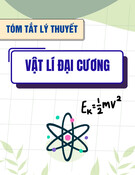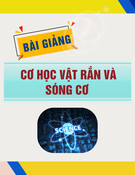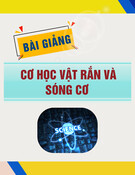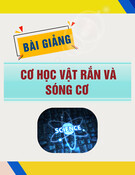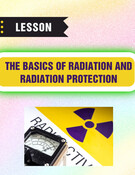
ISSN: 2615-9740
JOURNAL OF TECHNOLOGY EDUCATION SCIENCE
Ho Chi Minh City of Technology and Education
Website: https://jte.edu.vn
Email: jte@hcmute.edu.vn
JTE, Volume 20, Issue 01, 02/2025
91
Synthesis of ZnO Nanostructures for Photoluminescent Ink Applications
Thanh Phuong Nguyen*, Ngoc Nhung Thi Nguyen , Phuong Trinh Le Nguyen
Ho Chi Minh City University of Technology and Education, Vietnam
*Corresponding author. Email: phuongnt@hcmute.edu.vn
ARTICLE INFO
ABSTRACT
Received:
15/08/2024
In this study, we have successfully synthesized ZnO nanoparticles (ZnO
NPs) using co-precipitation and hydrothermal methods. ZnO NPs were
fabricated by co-precipitation for spherical shape, while the hydrothermal
method was for rod-shaped morphology. The XRD analysis shows that
ZnO NPs possess a hexagonal wurtzite structure for two synthesis
methods. The UV-Vis spectra analysis shows that the ZnO NPs have an
absorption peak at the wavelength of 355 nm. The PL spectra result
reveals that ZnO NPs synthesized by co-precipitation have two peaks at
about 570 nm and 650 nm, while ZnO nano-rods synthesized by the
hydrothermal method have a PL peak at 650 nm. Luminescent inks based
on ZnO nano-rods and nano spherical particles were printed on filter
paper using a screen printing method. The logos of the“Faculty of
Graphic Arts and Media” samples show bright yellow and pink
fluorescence under UV irradiation 365 nm and are invisible under normal
light.
Revised:
13/09/2024
Accepted:
23/10/2024
Published:
28/02/2025
KEYWORDS
ZnO nanoparticles;
Luminescent;
Counterfeiting;
Printing;
Ink.
Doi: https://doi.org/10.54644/jte.2025.1642
Copyright © JTE. This is an open access article distributed under the terms and conditions of the Creative Commons Attribution-NonCommercial 4.0
International License which permits unrestricted use, distribution, and reproduction in any medium for non-commercial purpose, provided the original work is
properly cited.
1. Introduction
ZnO nanoparticles (ZnO NPs) are nontoxic semiconductors with a wide bandgap (Eg ≈ 3.37 eV). Due to
their large exciton binding energy ( 60 ≈ meV), ZnO NPs are highly stable at room temperature. They are
applied in many fields, such as optoelectronics [1], [2], photocatalysis [3], packaging [4], [5], [6], and
luminescent inks [7].
Many studied results [1], [2], [7] indicated that ZnO NPs exhibit a strong emission in the visible light
region. Thus, they are suitable for security ink applications. Besides, polyvinyl alcohol (PVA) is a
biodegradable polymer with some advantages, such as a non-toxic, high-transparency film and being
accessible to dissolve in water. As a result, PVA can be applied in many fields, such as paper coating, glue,
pharmaceuticals, construction, packaging films, and especially printing ink. In printing ink applications, PVA
can be used as a distribution media and a viscosity modifier of the ink. These can be tailored to specific
concentrations and levels of viscosity to meet many established printing methodologies.
Investigated results recently show that ZnO NPs can be used in anti-counterfeiting ink applications [2],
[7], [11], for printed electronic devices [1], for antibacterial activities in conventional ink [8]-[10], and for
enhancing faster-drying ultraviolet (UV) offset printing inks. Few researchers have investigated the different
fluorescence emission colors of ZnO NPs applied in anti-counterfeit printing inks, especially in
photoluminescent ink applications. Thus, we have focused on the structural and photoluminescent ink
properties of ZnO NPs in this study.
2. Experiments
2.1. Materials
Zinc acetate (Zn(CH3COO)2.2H2O, 99%), Sodium hydroxide (NaOH 96%), and Poly(vinyl alcohol)
(PVA) used as a distribution media and the viscosity modifier of ink were purchased from Aldrich.
Citric acid monohydrate (C6H8O7.H2O) and ethylene glycol (C2H6O2) were purchased from Xilong.

ISSN: 2615-9740
JOURNAL OF TECHNOLOGY EDUCATION SCIENCE
Ho Chi Minh City of Technology and Education
Website: https://jte.edu.vn
Email: jte@hcmute.edu.vn
JTE, Volume 20, Issue 01, 02/2025
92
2.2. Synthesis of ZnO nanoparticles by co-precipitation method
Zn(CH3COO)2.2H2O, Sodium hydroxide (NaOH 96%), and poly(vinyl alcohol) (PVA) were used for
synthesis. First, 100 ml of 0.4 M Zn(CH3COO)2.2H2O solution was vigorously stirred for 45 min at
80◦C. Then, 100 ml of 0.2 M NaOH was dropped into the Zinc acetate solution. The white colloidal
solutions were then continuously stirred for 45 min, and the product was centrifuged at 6,000 rpm and
washed with deionized water.
2.3. Synthesis of ZnO nanoparticles by hydrothermal method.
ZnO nanoparticles (ZnO NPs) were synthesized using the hydrothermal method. The first solution
concentration of 0.4 M, containing 8.8 g of Zn(CH3COO)2.2H2O, was dissolved in 200 ml of deionized
water for 30 min at 80 oC. Then, a concentration of 2.8 M NaOH (5.8 g) was dissolved in 100 ml of
deionized water for 30 min at 80 oC. The second solution was dropped into the first solution and stirred
for 30 min at 80 oC to get the colloidal solution. Then, the solution was placed in the Teflon stainless
steel autoclave, which was hydrothermally heated at 100 oC for 12 h and then cooled to room
temperature.
2.4. Synthesis of luminescent ZnO nano ink
In this study, ZnO nanoparticles synthesized by the co-precipitation and hydrothermal methods were
used as pigments for ink formulation, and poly(vinyl alcohol) (PVA) was used as a distribution media
and the viscosity modifier of the ink. First, 20 g of PVA was dissolved in 200 ml of deionized water
using a magnetic stirrer. The mixture was continuously stirred overnight at 80 oC to get a transparent
solution. Second, the mixture of PVA solution, ethylene glycol (EG), and deionized water with the ratio
(w/w) of 1:4:10 was stirred together at 80 oC for 30 min. The mixture was used as the vehicle in an ink
formulation. Lately, ZnO nanoparticles 15% (w/w) were dispersed in the vehicle. The ink was
vigorously stirred for 1 h and homogenized using the ultrasonic method for 30 min. Citric acid was used
to adjust the pH of the ink. The ZnO nanoparticle ink (pH = 7) was printed on filter papers using the
screen printing technique (Fig. 1).
Fig. 1. ZnO luminescent ink printed on filter paper using the screen printing method
3. Results and discussions
3.1. Structural and morphological analysis
Fig. 2(a) displays the XRD pattern of ZnO nanoparticles (ZnO NPs) synthesized by the co-
precipitation method. The result shows that ZnO NPs have the hexagonal wurtzite structure (JCPDS 04-
020-0364) with the planes of (100), (002), (101), (102), (110), (103), (200), (112), (201). The average
crystallite size (D) calculated from formula (1) is about 17.5 nm.
0.9
cos
hkl
D
(1)
Where D, λ = 1.5406 Å, θ, and βhkl are the mean crystallite size, the X-ray wavelength, the Bragg angle,
and the full-width at half maximum (FWHM) of the diffraction peaks for the ZnO NPs, respectively.
Under
normal light
Under UV
365 nm light

ISSN: 2615-9740
JOURNAL OF TECHNOLOGY EDUCATION SCIENCE
Ho Chi Minh City of Technology and Education
Website: https://jte.edu.vn
Email: jte@hcmute.edu.vn
JTE, Volume 20, Issue 01, 02/2025
93
Fig. 2.(a) XRD patterns of ZnO NPs synthesized by the co-precipitation method, (b) SEM images of ZnO
nanoparticles
Fig. 2(b) illustrates the SEM image of ZnO NPs. The result indicates that ZnO NPs are spherical,
with average particle sizes of about 18 nm. This result is in good agreement with the XRD analysis.
Fig. 3.(a) XRD patterns of ZnO NPs synthesized by the hydrothermal method, (b) SEM images of ZnO nano-
rods
Fig. 3(a) shows the result of ZnO NPs synthesized by the hydrothermal method. ZnO NPs also
possess a hexagonal wurtzite structure (JCPDS 04-009-7657) similar to the co-precipitation method.
The average crystallite size is about 28 nm. Fig. 3(b) reveals SEM images of ZnO NPs synthesized in
an autoclave at temperatures of 100oC. The result shows the rod-shaped morphology of ZnO NPs. The
average length and width of ZnO Ns are about 500 nm and 80 nm, respectively.
3.2. Optical properties of ZnO nanoparticles (ZnO NPs)
Fig. 4 displays UV-vis spectra of ZnO NPs synthesized by hydrothermal and co-precipitation
methods. The UV-vis spectra shows the ZnO NPs’ absorption peak at about 355 nm. The result indicates
that the ZnO NPs are suitable for security ink applications. A UV light source with a wavelength of 365
nm may be used for excitation.
Fig. 5(a) shows the PL spectra of ZnO NPs fabricated by the hydrothermal and co-precipitation
methods. The result indicates that ZnO NPs synthesized by co-precipitation methods have a broad
emission at about 570 nm and 650 nm. The photoluminescence (PL) emission at 570 nm is attributed to
the transition from oxygen vacancies (VO) states to zinc vacancy (VZn) defects [12]. The PL emission at
650 nm is due to the transition between Zni and oxygen interstitials (Oi) states [12]. However, ZnO NPs
(a)
(b)
18 nm
(a
)
(
b)
500 nm
80 nm

ISSN: 2615-9740
JOURNAL OF TECHNOLOGY EDUCATION SCIENCE
Ho Chi Minh City of Technology and Education
Website: https://jte.edu.vn
Email: jte@hcmute.edu.vn
JTE, Volume 20, Issue 01, 02/2025
94
synthesized by the hydrothermal method show an emission peak at 650 nm. The PL peak related to
oxygen vacancies states was reduced, and the emission peak at 650 nm indicates the transition between
Zni and Oi states. Fig. 5(b) shows the CIE (x, y) color coordinates of ZnO nanoparticles with two
synthesized methods, respectively. The values of the CIE (x, y) change from yellow to near pink. The
PL analysis indicates that ZnO NPs synthesized by the two methods have the potential for luminescent
ink applications.
Fig. 4. UV-Vis spectra of ZnO nanoparticles synthesized by hydrothermal and co-precipitation methods
Fig. 5. (a) PL spectra of ZnO nanoparticles synthesized by hydrothermal and co-precipitation methods, (b)
CIE (x, y) diagram of ZnO nanoparticles with two synthesized methods
Fig. 6(a) and (b) show luminescent inks based on ZnO nano-rod pigments under normal light and
UV 365 nm light excitation, respectively. Fig. 6(c) and (d) display a logo sample of the Faculty of
Graphic Arts and Media printed on filter paper using the screen printing method under normal light and
UV 365 nm light. The result shows that the logo sample is invisible under normal light and emits pink
light under UV 365 nm excitation. Similarly, Fig. 6 (e) and (f) reveal the luminescent ink based on ZnO
nanoparticle pigments under normal light and UV light. The result indicates that the sample is invisible
(a)
(b)

ISSN: 2615-9740
JOURNAL OF TECHNOLOGY EDUCATION SCIENCE
Ho Chi Minh City of Technology and Education
Website: https://jte.edu.vn
Email: jte@hcmute.edu.vn
JTE, Volume 20, Issue 01, 02/2025
95
under normal light and emits bright yellow light under UV irradiation 365 nm. Therefore, ZnO
nanomaterials have potential applications in information encryption and anti-counterfeiting packaging.
Fig. 6. (a) Luminescent inks with ZnO nanoparticles synthesized by hydrothermal and co-precipitation
methods under normal light and UV 365 nm light, (b) Logos of Faculty of Graphic Arts and Media ZnO were
printed on filter paper by nano inks under normal light and UV 365 nm light.
4. Conclusion
In summary, ZnO nanomaterials were successfully synthesized by the co-precipitation and
hydrothermal methods. ZnO nanomaterials were used as luminescent pigments in an ink formulation.
ZnO nanopigments were dispersed in the vehicle, including PVA, water, and ethylene glycol, to obtain
an ink formulation. The fluorescent ink has a bright yellow and pink emission under UV irradiation 365
nm. The ZnO nano pigments-based fluorescent ink is environmentally friendly and can be used in the
fields of information encryption and anti-counterfeiting packaging.
Acknowledgments
This work belongs to the project grant No: SV2024-121. funded by Ho Chi Minh City University of
Technology and Education, Vietnam.
Conflict of Interest
The authors declare no conflict of interest.
REFERENCES
[1] O. Elkalashy and E. Sheha, "Attempt to tune the dielectric and optical properties in PVA/ZnO composite using tetra ethylene glycol
dimethyl ether for light emitting devices," Applied Physics A, vol. 124, no. 549, 2018.
[2] S. S. Mousavi, B. Sajad, and M. H. Majlesara, "Fast response ZnO/PVA nanocomposite-based photodiodes modified by graphene
quantum dots," Materials and Design, vol. 162, pp. 249–255, 2019.
[3] F. M. Sanakousar, C. C. Vidyasagar, V. M. J. Perez, and K. Prakash, "Recent progress on visible-light-driven metal and non-metal doped
ZnO nanostructures for photocatalytic degradation of organic pollutants," Materials Science in Semiconductor Processing, vol. 140, p.
106390, 2022.
[4] R. Venkatesan, T. T. Thiyagu, and N. Rajeswari, "Zinc composite materials and food packaging," in Composites Materials for Food
Packaging, vol. 4, pp. 153-173, 2018.
[5] Y. H. Wen et al., "Antibacterial nanocomposite films of poly(vinyl alcohol) modified with zinc oxide-doped multiwalled carbon
nanotubes as food packaging," Polymer Bulletin, Jun. 2022.
(a)
(b)
(c)
(d)
(e)
(f)
(g)
(h
)

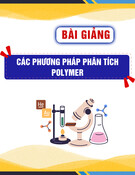


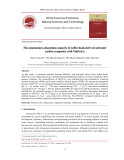
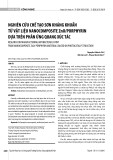
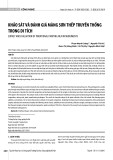
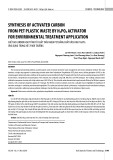
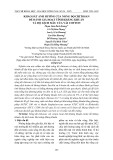

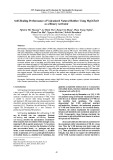
![Bài giảng Vật lý đại cương Chương 4 Học viện Kỹ thuật mật mã [Chuẩn SEO]](https://cdn.tailieu.vn/images/document/thumbnail/2025/20250925/kimphuong1001/135x160/46461758790667.jpg)




